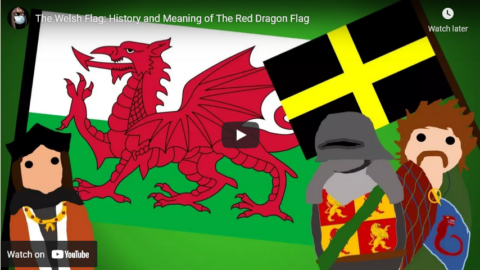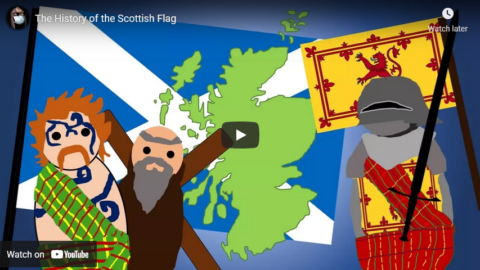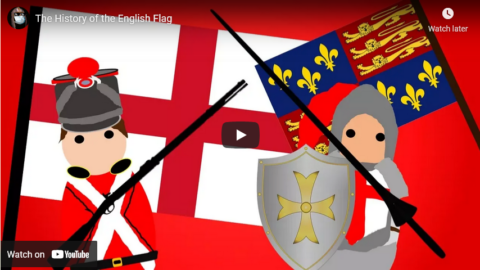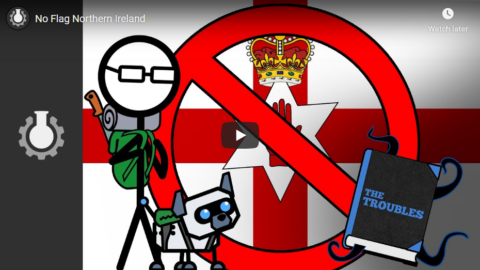History With Hilbert
Published 16 May 2018You may think it’s a bit odd that I’m making a video in the Union Flag Series about the Welsh flag, given that it’s the only part of the United Kingdom not represented on the country’s flag. However Wales is great, and its flag has some interesting history and symbolism so you’re just going to have to deal with it. In this one I’ll be look at the Welsh Dragon Flag, at the figures of Cadwalladr ap Cadwallon (and his dad), Owain Glyndŵr, Henry VII and many more.
Music Used:
“Sneaky Snitch” – Kevin MacLeod
“Teller of the Tales” – Kevin MacLeod
“Up and Away” – Holfix
https://www.youtube.com/watch?v=9YmM_…
“Celtic Impulse” – Kevin MacLeod (incompetech.com)
Licensed under Creative Commons: By Attribution 3.0 LicenseAll images are from the Public Domain of Wikimedia Commons and Pixabay with the following exception:
Owain Glyndŵr’s Flag – Hogyncymru:
https://creativecommons.org/licenses/…
June 14, 2021
The Welsh Flag: History and Meaning of The Red Dragon Flag
June 10, 2021
“That’s a nice Pride flag you’ve got there. Be a shame if something were to happen to it …”
In The Line, Allan Stratton argues against replacing the common “rainbow” Pride flag with a new “Progress” variant:
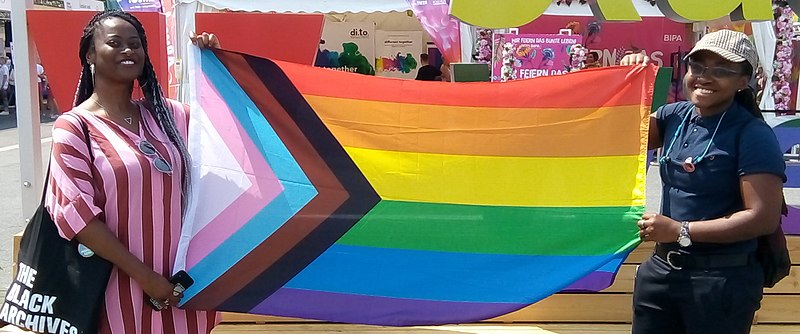
Two people at EuroPride 2019 in Vienna holding an LGBTQ+ pride rainbow flag featuring a design by Daniel Quasar; this variation of the rainbow flag was initially promoted as “Progress” a PRIDE Flag Reboot.
Photo by Bojan Cvetanović via Wikimedia Commons.
Question: What do the following have in common: A hammer and sickle, a Union Jack, five interlocked rings, a Black fist, a cross, a Star of David, and the Rainbow flag?
Answer: They are internationally recognized symbols. Not spring fashions. Not cool memes. No. Symbols that communicate across all languages and countries in the world.
That’s what’s so infuriating about the push by hashtag activists to replace the Rainbow flag with the so-called “Progress flag”. The Progress flag takes the pink, blue, and white stripes of the trans flag, adds black and brown stripes for race, turns those five stripes into a chevron tipped on its side, and ploughs it into the rainbow in an eleven-colour pile-up. It’s a regressive, ill-considered mess that looks like a child’s Crayola box.
Naturally, it’s the creation of a Portland designer who whipped it off one night while suffering insomnia. The story of Daniel Quasar (ze/them) and their flag is a real-life satire, featuring moxie, hustle, viral posts and a Kickstarter campaign. Ze and their (not surprisingly) all-white team have leveraged ze’s design into Quasar Digital, a company that sells Progress flags, pins, patches, T-shirts, tank tops, notebooks, clutch bags, coffee mugs, stickers, slappers, socks and more, individually and in bundles.
Marketed with the trendy buzzwords progress, diversity and inclusion, the Progress flag has been a viral hit with woke straights and nouveau queers as well as corporate PR departments at places like Goldman Sachs and TD Bank, who signal virtue while screwing customers of every gender. But by separating specific races and a single identity from the rainbow, the Progress flag creates divisions, hierarchies and exclusions. And it trashes the power and weight that a 43-year-old symbol of hope and strength gives to people worldwide who continue to be imprisoned, beaten and murdered for being LGBT+.
[…]
Slapping the “Progress” chevron on the Rainbow is like slapping the fleur de lys on the Maple Leaf. It creates resentment and division to the sole benefit of performative social climbers keen to wave their Alphabet status and cachet. Step outside the West to see what it really means to have people out to “deny your very existence”. To trade the Rainbow, the symbol of our suffering and resilience, for a viral craze is bourgeois privilege at its self-indulgent worst.
June 7, 2021
The History of the Scottish Flag
History With Hilbert
Published 4 May 2018One of the most prominent parts of the Union Flag is the Scottish Flag or Saltire, which is a bonny flag in its own right as well. In this video, as part 2 of my series on the Union Flag and the flags that make it up, I’m going to look at why this flag became the Scottish flag, what’s the symbolism behind it and which ones came before it. Lots of vexiology, historiography and etymology to come, strap in because this, is History with Hilbert!
Music Used:
“Sneaky Snitch” – Kevin MacLeod
“Up and Away” – Holfix
https://www.youtube.com/watch?v=9YmM_…
“Heroes – CO.AG”:
https://www.youtube.com/watch?v=V9yVZ…
“Eastern Thought” – Kevin MacLeod (incompetech.com)
Licensed under Creative Commons: By Attribution 3.0 LicenseAll images are from the Public Domain of Wikimedia Commons and Pixabay.
June 4, 2021
“I’m talking about the Pride flag. That omnipresent rainbow eyesore. A virtue-signal made cloth.”
Brendan O’Neill seems to have had it up to here with the rainbow flag being used everywhere at all times, the unbearable annoyingness of Pride:

“Pride Flags, Commercial Street, Provincetown, Credit: Tim Grafft/MOTT” by Massachusetts Office of Travel & Tourism is licensed under CC BY-ND 2.0
I see the flag-shaggers are out in force. No, not working-class people who hang the Union flag from their living-room window as an expression of pride in their nation. I’m talking about the Pride flag. That omnipresent rainbow eyesore. A virtue-signal made cloth. The flag no one can escape. Yep, it’s Pride Month, which means that everywhere you go for the next four weeks – the bank, the supermarket, Maccy D’s – you’ll have this flag waved in your face to remind you not to be such a horrible, homophobic piece of shit. Happy Pride Month!
God, Pride has become annoying. It’s so gratingly ubiquitous. I haven’t seen this much smug flag-waving since 100,000 Guardian readers wrapped in the EU colours, tears streaking their blue-painted faces, descended on Whitehall to demand the cancellation of stupid northern people’s votes. And yet the people who cry “flag-shagger!” every time Keir Starmer stands stiffly next to the Union flag, or when Robert Jenrick goes on TV with a backdrop of showy British memorabilia, are curiously silent about the adorning of every building in the land with the bloody Pride flag.
You can’t move for rainbows right now. The Pride flag will flutter from town halls across the country. Some schools in Scotland will fly the flag for the whole month. I can’t be the only person who found the photo of school pupils wearing Pride face masks beneath a vast Pride flag somewhat chilling. It’s borderline cultish. Go to a cashpoint machine and you’ll be told about Pride. Coutts Bank on The Strand in London once painted its entire facade in the Pride colours. That was a very expensive way of saying: “We’re nice, I swear.”
Cops will wear Pride-coloured badges. They’ll do dad-dancing at Pride marches and everyone will go wild for it (except the Daily Mail probably). The army is getting in on the act. It is using Pride Month to showcase its British Army LGBT+ Network. If this doesn’t become a meme featuring someone in the Middle East saying “They say the next bombs will be dropped by people who believe in gay rights! Don’t you love progress!”, I will lose all faith in the internet. Even the Beano is flag-shagging. It posted a comic strip featuring Dennis the Menace in a Pride-coloured jumper. I preferred him when he was bullying Walter the Softy.
Snacks are propaganda now, too. Who can forget M&S’s Pride sandwich, which was basically a club sandwich with added guacamole (“Gays like guacamole, right?”). McDonald’s has created Rainbow-coloured boxes for its French fries, which was definitely one of the key demands of the radicals who took part in the Stonewall riot of 1969 that Pride is meant to commemorate. Skittles surely caused even Pride aficionados’ eyes to roll when they released limited-edition white versions of their sweets, because “we are giving up our rainbow to show support for the LGBTQ+ community”. (It is testament to the insanity of intersectionalism that the only complaint about this conceited act of corporate virtue-signalling was that the sweets were white.)
May 30, 2021
The History of the English Flag
History With Hilbert
Published 13 Apr 2018Most people know that the Union Flag (sometimes incorrectly called the Union Jack by normies) is made up of the various flags of the United Kingdom combining things like the Scottish Saltire and the English Saint George’s Cross. But what is the history behind these symbols and why were they adopted by these nations, and what is more, why these flags, and what about the competitors who if history had been different might have come to symbolise these nations. In today’s episode, I’m going to explore the history and symbolism behind England’s flag, the Saint George’s Cross, as well as the other banners that were once seen as being representative of the English people.
Music Used:
“Sneaky Snitch” – Kevin MacLeod
“Pippin the Hunchback” – Kevin MacLeod
“Angevin” – Kevin MacLeod
“Gregorian Chant” – Kevin MacLeod
“Ever Mindful” – Kevin MacLeod
“Ever Mindful” – Kevin MacLeod (incompetech.com)
Licensed under Creative Commons: By Attribution 3.0 LicenseAll images are from the Public Domain of Wikimedia Commons and Pixabay.
July 22, 2019
No Flag Northern Ireland
March 18, 2018
QotD: National flags
If you have never investigated or thought through this odd phenomenon of national anthems, it might not occur to you that it is not OK to tamper with the lyrics. There was a time not so long ago when national flag etiquette was fairly severe. Flags were seen as essentially military emblems, and their use was informed by military protocols. When flags started to be turned into clothing and ironic art in the 1960s, and were exposed to the demoralizing effects of marketed consumer kitsch in the 1970s, these developments were greeted with unease. Not so much in Canada, of course: our flag was invented as a marketing device in a time of consumerism, and it had not been used to soak up oceans of blood, so it lacks the sobering associations other flags have. It had a virgin birth. We are quite welcome to slap it onto a backpack or a truck bumper.
The point is that flags can now be visually remixed with near-total freedom by artists and designers and inserted into all sorts of contexts with relatively little discomfort. If you want to put Donald Trump in an editorial cartoon with a gore-oozing Stars and Stripes, no contemporary American will kick up too much fuss. Yet the taboos around anthems, as Remigio Pereira discovered, seem to have grown stronger. And even as someone who was instinctively furious with him, I am not quite sure how this happened, or why.
Colby Cosh, “Let’s talk about anthems”, National Post, 2016-07-14.
November 8, 2017
Why Don’t Country Flags Use The Color Purple?
After Skool
Published on 17 Oct 2017For centuries purple dye was worth more than gold. The dye used to produce purple fabric came from a sea snail that only lived off the shores of modern day Lebanon. Because it was so rare, purple became associated with royalty. This is the reason you don’t see purple on country flags. It was just too expensive to produce.
Sometimes the simplest questions have extraordinary answers.
July 15, 2017
The Canadian Red Ensign
Elizabeth mentioned to me the other day that some idiots in the Canadian alt-right movement are attempting to hijack the Canadian Red Ensign as their version of the Confederate battle flag. Given how historically illiterate reporters tend to be, it’s not surprising that they appear to be buying this line in their coverage of protest groups like the “Proud Boys”. In the Edmonton Journal, Paula Simons tries to put in a good word for the flag Canada used up until 1965:
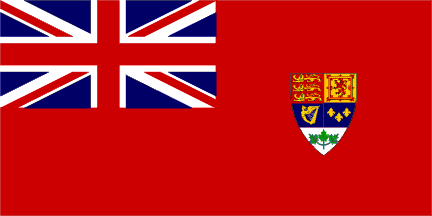
Canadian Red Ensign 1921-1957 (this is the version I’ve been flying outside my house for over a decade)
First they came for Pepe the Frog. And I said nothing because, to be honest, I didn’t much care that alt-right trolls and white supremacists had co-opted an innocent cartoon frog meme for their own foul purposes.
But now they’ve come for the Red Ensign.
On Canada Day, a small group of alt-right agitators who called themselves the Proud Boys disrupted a First Nations ceremonial event in Halifax. They arrived carrying a Red Ensign flag.
While the Red Ensign was never Canada’s official flag, different variations of it served as Canada’s de facto symbol from 1868 until 1965, when we adopted the red-and-white Maple Leaf flag.
The Proud Boys aren’t alone.
All kinds of conservative fringe groups have adopted the Red Ensign as their standard in recent years. They range from the pseudo-intellectual Northern Dawn movement to the more overtly neo-Nazi Aryan Guard. The idea is to somehow turn the Red Ensign into the Canadian version of the Confederate flag, a symbol of white supremacy. The flag, they believe, hearkens back to some mythical era of when Canada was “pure” and “white.”
This ahistorical appropriation of the Red Ensign isn’t new. It goes back to the early 2000s. But the Proud Boys, the anti-feminist, pro-white group started by journalist turned shock comic turned activist Gavin McInnes, have been getting much more attention. That’s because McInnes is such a canny public provocateur and a master media manipulator.
His racism, sexism and anti-Semitism are supposedly ironic and performative — he’s made hate-mongering into a kind of performance art.
[…]
The Red Ensign has been part of Canadian history since 1682 when the Hudson’s Bay Company flew a variation of the pennant over its forts and on its canoes. It followed Canadians into battle at Vimy Ridge and at Dieppe and Hong Kong and Normandy and Ortona. That’s the flag Canadians flew when they liberated Holland from the Nazis. It’s the flag Canadians flew when they defended South Korea at the Battle of Kapyong, the flag they flew when they went to keep peace in Cyprus.
August 1, 2016
A new flag for the Canadian Army
Chris Banks posted a link to this article in the Lorne Scots Facebook group:
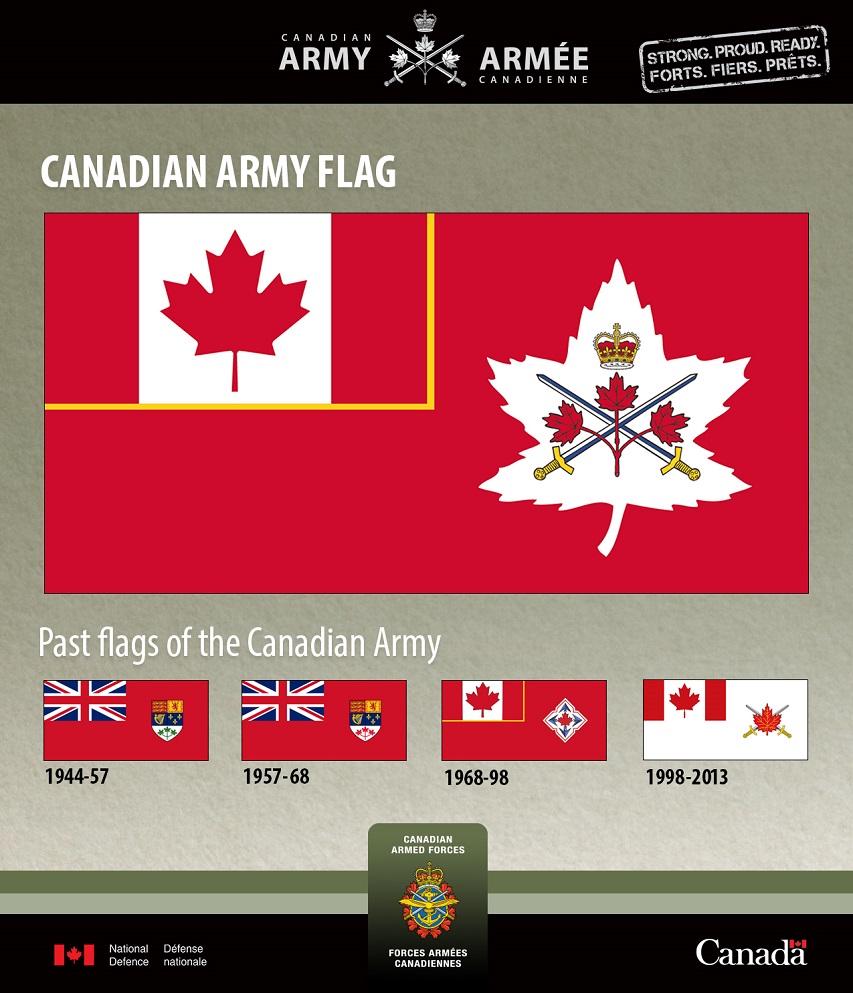
The Canadian Army (CA) will advance into the future under a new flag that nods to its proud past.
The flag was unveiled July 14, 2016, during a ceremony on Parliament Hill in which CA members welcomed their new Commander, Lieutenant-General Paul Wynnyk.
The new design features the Canadian flag and a white, stylized maple leaf against a red background. Superimposed on the white maple leaf is the badge that members used during the Second World War and the Korean conflict, consisting of three maple leaves over a pair of crossed swords. Sitting atop the centre leaf is an image of St. Edward’s Crown, a symbol that has been used in coronation ceremonies for over 300 years.
The maple leaf was worn on the collars of Canadian soldiers who fought in the Battle of Vimy Ridge during the First World War, and was included on the new flag to honour the 100th anniversary of the battle, which will be marked in 2017. The same maple leaf flew on the Headquarters flags of the fighting Divisions during the Second World War and still flies across Canada at the CA’s various Division Headquarters.
October 11, 2014
Display of naval flags on Her Majesty’s Canadian ships
From the Royal Canadian Navy’s website:
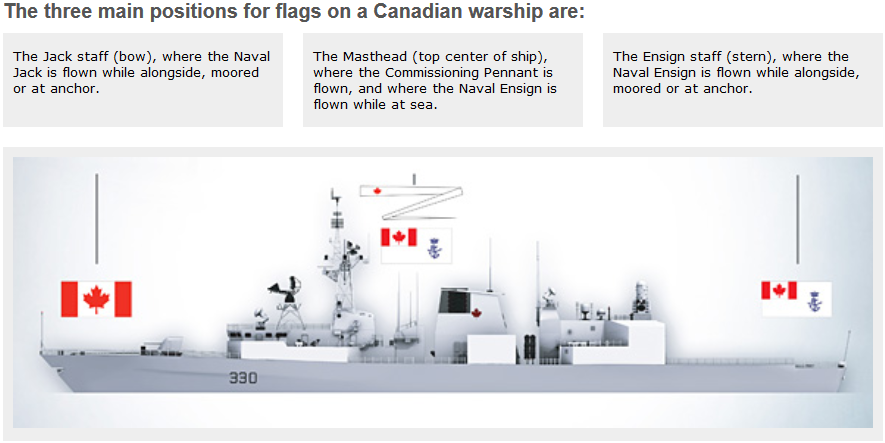
Canadian Naval Ensign
The Naval Ensign is flown at the masthead while at sea, or at the stern when alongside, moored or at anchor.
Canadian Naval Jack
The Naval Jack is flown at the bow when alongside, moored or at anchor.
Commissioning Pennant
Flown from the masthead, the Commissioning Pennant is hoisted on the day a warship is commissioned and is displaced only by the personal flag of the Sovereign or senior officer when embarked.
September 19, 2014
When Royal Navy submarines fly the “Jolly Roger”
Ali Kefford on the origins of a colourful naval tradition:
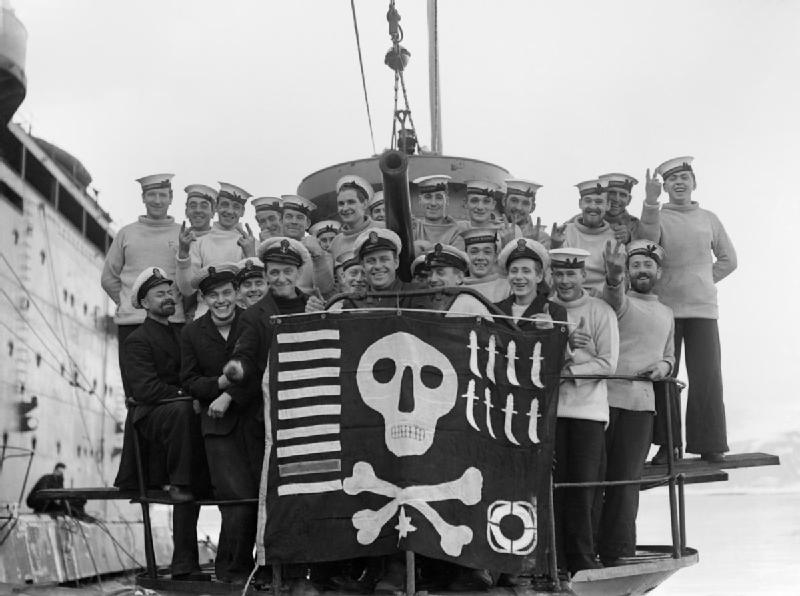
Members of the crew of HMS Utmost with their “Jolly Roger” success flag, photographed alongside HMS Forth in Holy Loch, on their return from a year’s service in the Mediterranean, 6 February 1942. (via Wikipedia)
Sir Arthur Wilson was infamous within the Royal Navy for being an admiral with a tetchy temper. His nickname – Old ’Ard ’Art – was a bad joke about his uncaring nature.
Yet a verbal broadside he delivered in 1901 was to spawn one of the Submarine Service’s most loved and deeply ingrained traditions – the flying of the Jolly Roger flag to mark the victorious return from a successful patrol.
Wilson, later a hugely unpopular First Sea Lord, is said to have blasted the innovation of submarines, dubbing the covert way they operated as “underhand, unfair and damned un-English”.
He even went so far as to say: “They’ll never be any use in war and I’ll tell you why. I’m going to get the First Lord to announce that we intend to treat all submarines as pirate vessels in wartime and that we’ll hang all the crews.”
[…]
One hundred years ago this week, shortly after the start of the Great War, British submarine HMS E9 despatched two torpedoes at close range at Germany’s SMS Hela in a skirmish off Heligoland.
Its commanding officer, Lieutenant Commander Max Horton, had to dive immediately to avoid return fire, so he did not see the cruiser sink.
But the 13-year-old Silent Service had notched up its very first kill, confirming the deadly effectiveness of sneaking around in the deep then launching a surprise attack on an enemy.
Horton, recalling Admiral Wilson’s words, told his signaller to sew a piratical Jolly Roger flag, which flew proudly from his boat’s periscope as she sailed into Harwich, Essex.
A naval tradition was born, as the skull and crossbones went on to be the Royal Navy Submarine Service’s official emblem.
The tradition continues to today:
RT @shaunwatchorn: HMS Triumph returning to Devonport after tomahawk raid on Libya pic.twitter.com/dzRf8UYsFk
— NavyLookout (@NavyLookout) September 19, 2014
March 11, 2014
New Zealand considering changing the national flag
The current PM’s choice would be the silver fern on a black field, which is the symbol used by the national sports teams, especially the All Blacks:
New Zealand is to hold a referendum on whether to change the national flag, Prime Minister John Key has announced.
Mr Key, who on Monday called an election for 20 September, said the vote would be held within three years.
The current flag shows the Southern Cross constellation and includes the Union Jack – the UK’s national flag – in one corner.
Mr Key said the flag represented a period of history from which New Zealand had moved on.
“It’s my belief… that the design of the New Zealand flag symbolises a colonial and post-colonial era whose time has passed,” he said in a speech at Victoria University.
“The flag remains dominated by the Union Jack in a way that we ourselves are no longer dominated by the United Kingdom.”
“I am proposing that we take one more step in the evolution of modern New Zealand by acknowledging our independence through a new flag.”
Mr Key said that he liked the silver fern — popularised by national teams including the All Blacks — as an option, saying efforts by New Zealand’s athletes gave “the silver fern on a black background a distinctive and uniquely New Zealand identity”.

